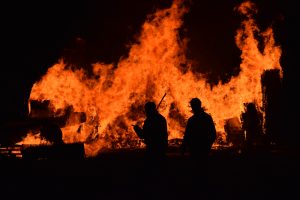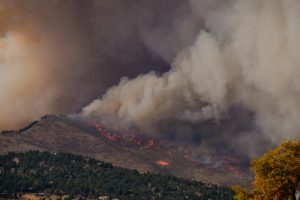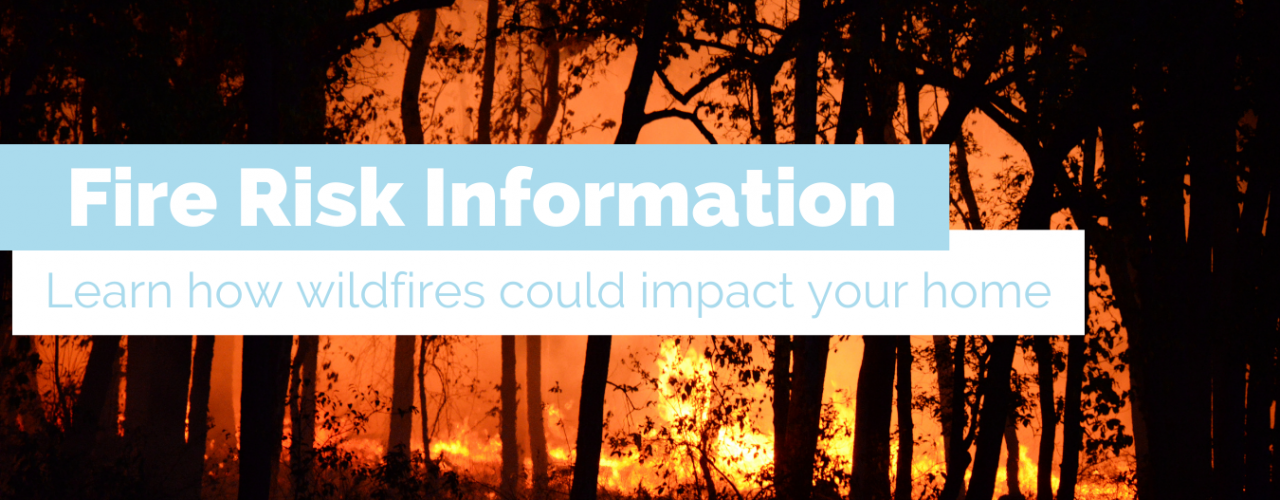
With climate change fueling the risk of wildfires and longer fire seasons, more homes are becoming at risk each year. Review our FAQs to learn how many homes are destroyed by wildfires each year, what’s considered a high-risk fire zone, and how to protect your home from wildfires.
Using information from First Street Foundation and ClimateCheck, to provide comprehensive climate risk information for every zip code, neighborhood, city, and county in the contiguous U.S.
Ready to find your dream home?
It’s that easy. Let us put our experience to work for you.
Fire Risk Frequently Asked Questions
What is a wildfire?
A wildfire is an unwanted, unplanned, and uncontrolled fire. Carried with the wind, wildfire embers – burning pieces of airborne vegetation or wood – can cause spot fires and ignite debris, homes, and other buildings.
People and lightning are the two leading causes of wildfires in the U.S.; human activity caused about 85% of wildfires in the U.S. between 2000 and 2017. Let’s look at how you can keep your home and property safe from wildfires and get proper insurance coverage.
Does my homeowner’s insurance cover damage caused by wildfires?
Typically, your homeowner’s insurance policy will cover damage from fire, including wildfires. For example, if a wildfire damages your house the policy will include coverage to help repair or rebuild the home and other structures, pay for temporary housing, and replace belongings. The cost and extent of coverage can vary with the wildfire risk in your geographic area.
Check your policy to understand your deductible and the specific coverage details for wildfire damage to your dwelling, personal property, other structures. Know that some insurance companies will increase deductibles or decline to issue policies for homes in high-risk areas. In this case, you’ll need to get additional wildfire insurance coverage for your home. If you can’t find homeowners or wildfire insurance in your area, you might need to turn to your state’s Fair Access to Insurance Requirements (FAIR) Plan to purchase an insurance policy.
Does my renter’s insurance cover damage from wildfires?
Renters can rest assured that their standard renter’s insurance policy covers damages caused by wildfires. This will include your possessions, additional living expenses, and loss of use. However, you can’t rely on your landlord’s policy to cover extra expenses like lodging and meals.
As you look at neighborhoods and homes, here are a few characteristics to look out for when buying a home in a fire zone to help you reduce the risk of wildfire damage to your home.
1) The density of the area and zoning: A real estate agent should tell you if the home is located in a flood, fire, or earthquake zone.
2) Existing wildfire mitigation and fire safety features: Look for homes where steps have been taken to reduce wildfire risk, including fire-resistant roofs and siding, proper landscaping a correct distance away from home. Ideally, homes should have two exits on each level.
How to fireproof your home from wildfires
How fast a wildfire spreads depends on the weather conditions, vegetation, and environment. Drought, extreme heat, and high winds can also cause a fire to spread more quickly. Protecting your home starts with small, manageable steps, and there are many low-cost improvements you can make to fireproof your home from wildfires. You’ll want to start with the roof since it’s the most vulnerable part of your home and work your way down. Clean out your gutters and clear flammable materials such as dead leaves to prevent the risk of flammable debris from igniting and causing a wildfire.
a wildfire.
From there, you can make more extensive fireproofing improvements such as covering your home with non-combustible Class A roofing, composite shingles, metal, concrete, or clay tiles and replacing windows with multi-pane or tempered glass. You’ll also want to choose nonflammable gates and fencing and replace your deck with non-combustible deck boards designed for wildfire-prone areas.
How many homes are destroyed by wildfires each year?
Is my home at risk of damage or destruction from a wildfire?
Depending on your location, your home may be at risk of a wildfire. The National Interagency Fire Center has mapped out all of the fires from 2007 to 2021. The wildfire risk map shows active wildfires and how many acres are burning at the onset of the fire.
In the U.S., most wildfires occur in states in the East and central region. Still, wildfires in the Western states – Alaska, Arizona, California, Colorado, Idaho, Montana, New Mexico, Nevada, Oregon, Utah, Washington, and Wyoming – tend to make the news because they burn more acreage. To see if your home is at risk of wildfire, you can check out your location at wildfire risk.org.
Do I live in a high-risk fire zone?
When buying a home, it’s important to know what fire zone your house is located in. The highest-risk zones for wildfires are locations where vegetation and homes meet. This is called the wildland-urban interface or WUI. The University of Wisconsin-Madison has mapped fires in the WUI from 2000-2010. Between 2000-2013, over 70% of the buildings destroyed by fire have been located in the WUI.
Wildfires can occur any time of year but are most common during the hotter months. As a homeowner, it’s essential to take action each year to mitigate wildfire risk around your property and prepare your home to withstand wind-borne embers.
The Top 10 U.S. Cities Most at Risk of Fire Damage
| Rank | City | Buildings with significant fire risk | Increase in burn risk | Average percent burned (historical) | Average percent burned (max, 2020-2060) |
|---|---|---|---|---|---|
| 1 | San Jose, CA | 32% | 2X | 0.01 | 0.03 |
| 2 | Colorado Springs, CO | 65% | 2.5x | 0.01 | 0.02 |
| 3 | Portland, OR | 24% | 50x | 0.00 | 0.02 |
| 4 | Wichita, KS | 36% | 1.2x | 0.05 | 0.05 |
| 5 | Los Angeles, CA | 27% | 2.7x | 0.01 | 0.03 |
| 6 | New Orleans, LA | 8% | 1.1x | 0.03 | 0.03 |
| 7 | St. Paul, MN | 38% | 1.4x | 0.03 | 0.04 |
| 8 | Oklahoma City, OK | 61% | 1.1x | 0.03 | 0.04 |
| 9 | Aurora, CO | 57% | 16x | 0.00 | 0.02 |
| 10 | Sacramento, CA | 30% | 1.5x | 0.02 | 0.03 |
Interested in moving out of these areas of fire damage?
It’s that easy. Let us put our experience to work for you.
*Fire risk is measured by the potential severity of a fire and its likelihood of happening in an area (percent burned). For each city, column values correspond to averages for buildings that have fire risk. The approximate percentage of buildings with significant fire risk are noted.



